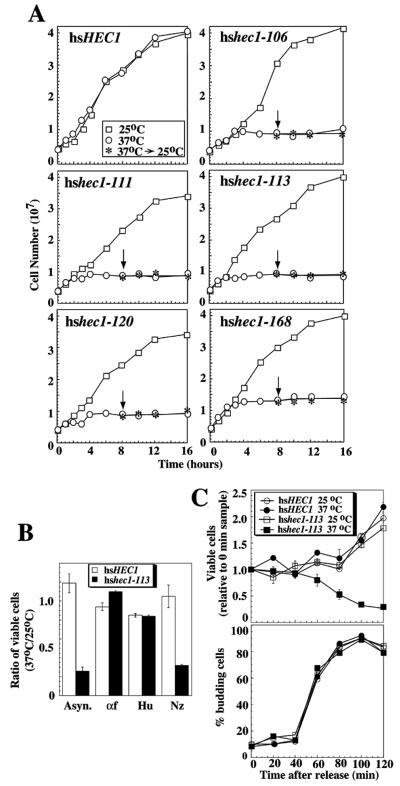FIG. 2.
Temperature sensitivity of mutated hshec1 alleles. (A) Growth-density curves of yeast strains carrying different mutant alleles or the wild-type allele of hsHEC1 were measured by spectrophotometric methods. Log-phase cells originally growing at 25°C were inoculated and cultured at 25 or 37°C, respectively. After 8 h, half of the cultures grown at 37°C were shifted back to 25°C, as indicated by arrows. (B) Log-phase cells from hsHEC1 or hshec1-113 strains were arrested with α-factor at 5 μg/ml, hydroxyurea at 0.1 M, or nocodazole at 20 μg/ml or were left untreated for 3 h at 25°C. The percentages of arrested cells, determined by DAPI staining and observation by fluorescence microscopy, were between 85 to 95%. While arrested, half of each culture was shifted to 37°C and the remaining was kept at 25°C. After another 3-h incubation, cells were released and plated at 25°C. The ratios between the numbers of colonies formed by the cells exposed to 37°C and those by the cells exposed to 25°C are shown by histograms. Asyn., asynchronous; αf, α-factor; Hu, hydroxyurea; Nz, nocodazole. (C) Log-phase cells from hsHEC1 or hshec1-113 strains were arrested with α-factor at 5 μg/ml for 3 h at 25°C. Immediately after release, half of each culture was shifted to 37°C and the remaining half was kept at 25°C. The numbers of colonies formed by equal aliquots taken from these cultures every 20 min were counted from duplicated plates. Numbers of colonies formed for each sample relative to the 0-min sample were calculated to generate the curves in the upper panel. The lower panel shows the percentages of budding cells in each sample.

